VikingGenetics is a worldwide Artificial Insemination (AI) company owned by 25,000 beef and dairy farmers in Denmark, Sweden and Finland and a leader in providing genetics to improve cattle breeding with healthy, fertile and high producing cows. The unique Nordic registration system is the cornerstone of our breeding aims, making it possible to breed for healthy cows, which has proven to be the best way to maximize the bottom line for dairy businesses.
VikingGenetics genomically tests 6,000 bull calves and progeny tests 220 bulls annually for Holstein, VikingRed and Jersey. The company has a registration system containing relevant data on approximately 900,000 milk recorded cows. Although VikingGenetics has only been operating through a subsidiary for 12 months in the United Kingdom, our genetics have been part of UK dairy cattle breeding for many years.
The following will be discussed within this paper:
• About the VikingGenetics breeding program
• Breeding is part of the solution in successful dairy production
• Principles of Scandinavian breeding
• Registration system in the Nordic countries
• Benefits of direct selection
• Disease prevalence in the Nordic countries – Mastitis and Hoof disorders compared to the UK
Breeding program in Scandinavia
VikingGenetics is responsible for a joint breeding programme in Denmark, Sweden and Finland. Our three main dairy breeds; Holstein, VikingRed and Jersey are the foundation of our breeding programme. Dairy Associations for the three countries have established a breeding goal for the most profitable dairy cows. The Scandinavian breeding programme aims for sustainable breeding that focuses on healthy and high producing cows. What’s more, the Nordic breeding goal seeks to benefit not only the dairy business in particular but humans, livestock and the environment in general.
Is breeding for healthy cows and high production possible?
Dairy farmers in the Nordic countries clearly understand that breeding is a crucial part of ensuring a successful dairy business, a part of the management tool, just as important as finance, feeding and management.
A natural defence against diseases in the genes is at the heart of our Scandinavian philosophy, driven by the fact that Nordic countries have very strict veterinary regulations regarding the use of antibiotics. With limited access to antibiotics, the dairy industry has been compelled to find other ways of keeping cows healthy.
The Nordic tradition in breeding for healthy cows is reflected in the latest report from the European Medicines Agency (EMA), from 2016: ‘Sales of veterinary antimicrobial agents in 29 European countries in 2014’. According to this report, Sweden, Finland and Denmark are the EU member states with the lowest use of antibiotics in livestock, with an outstanding leading position (see Table 1).
Table 1
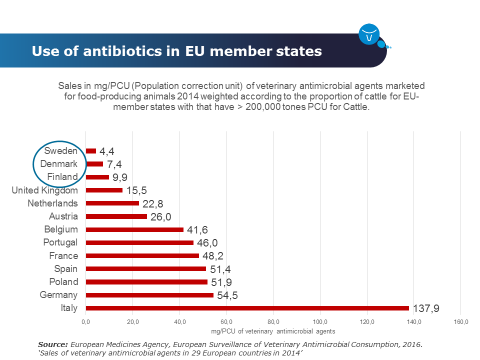
The situation regarding the use of antibiotics in cattle breeding in the UK is of particular concern. The Agricultural Authorities in the UK are aiming for a reduction of 20% of mg/PCU (population correction unit) by 2020, based on a plan dating from 2015.
According to The Alliance to Save Our Antibiotics in the UK, only 40% of inframammary antibiotics are used for sick cows, meaning that 60% of such use is on healthy cows (as prevention and growth promotion). In addition, 85% of non-organic farms use routine non-selective dry-cow therapy and there are at least two antibiotic treatments per cow, per year.
On the other hand, Scandinavian farmers not only have the lowest use of antibiotics but also the highest milk yield per cow in 305 days, in kg all recorded cows and all breeds together, according to the International Committee for Animal Recording (ICAR) (see Table 2).
Table 2
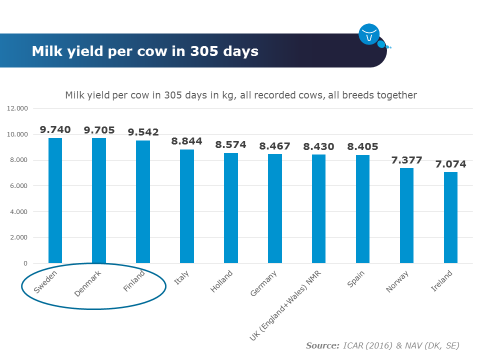
Sweden has an average of kg milk of 9,740 kg, Denmark 9,705 kg and Finland 9,542 kg. Meanwhile, the average in the United Kingdom (England + Wales) is 8,430 kg, Norway 7,377 kg, Ireland 7,074 kg and Spain 8,405 kg.
What is behind the success of Nordic dairy farming?
The answer is simple and straightforward: The Nordic Total Merit (NTM) index where 60 sub traits are combined into 14 main traits. In the NTM index, all traits are of economic importance and the weightings are distributed with 50% for health and fertility traits, 30% for production and 20% for conformation.
The Nordic countries have over 40 years of experience in breeding for health and when it comes to the General Health index, the information is based on veterinary registrations of more than 80 diagnoses which have been recorded since 1987.
Registrations of Mastitis resistance started in 1982, Hoof Health data collection started in 2003; while data collection for the Young stock survival index started in the 1990’s.
The Nordic registration system: information from 90% of the cow population
The Nordic countries have a central database where farmers (under veterinary supervision), veterinarians and hoof trimmers record all clinical diseases on every single cow. All data are sent to NAV (Nordic Cattle Genetic Evaluation), which is responsible for evaluating, investigating and monitoring genetic trends to form the best and most reliable breeding values.
This valuable information is the foundation of the NTM, to identify the sires with the best genetic potential to transmit resistance to health problems, such as reproductive and metabolic diseases and mastitis and hoof disorders.
• 90% of cows in the Nordic countries are in Milk Recording
• 90% of the cows contribute to registrations on General Health
• 85% of the cows are registered to provide data on Fertility
• 40% of the cows provide information on Hoof Health
The strength of the registration system in the Nordic countries is that the data is based on a high proportion of cows in variating environment rather than selected herds. Having this amount of data, makes breeding for better health and production possible.
Breeding for better health traits, does it work in practice?
In modern dairy cattle operations around the world, mastitis is one of the most frequent infectious diseases, and accounts for most of the doses of antibiotics given to dairy cows. In the Nordic Countries, farmers make a direct selection for actual clinical diseases registered under the indices: General Health, Hoof Health, and Udder Health in the NTM.
Breeding becomes far more successful when you make a direct selection of traits to target genetic progress, rather than simply relying on correlated measurements such as somatic cell count, feet and legs, or immunity. Breeding directly for health traits is possible when you have a large volume of high quality and reliable data for the diseases in question (see Table 3).
Table 3
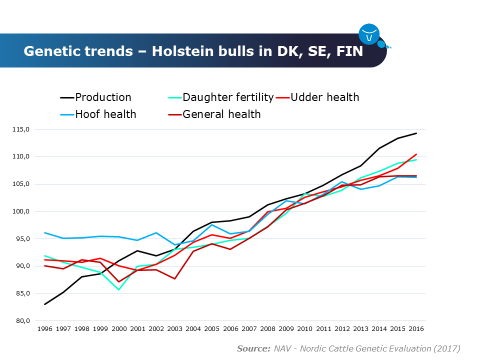
Over the last fifteen years, there has been a significant improvement in the health situation of Swedish dairy cows. Table 4 shows disease incidence in dairy cows enrolled in the Swedish milk recording scheme per 100 cows per year, for the period 2001–2016. In 2001, disease incidence was 35 cases per 100 cows, in 2016 that number was 20 cases – a 44% decrease.
Table 4
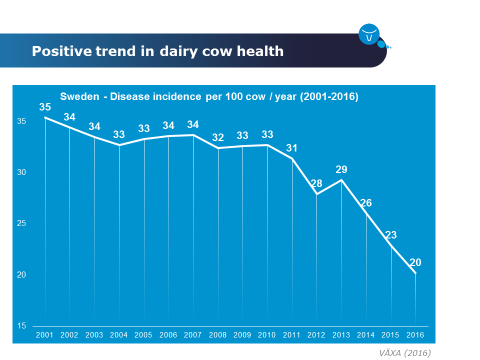
Disease prevalence in the Nordic countries – Mastitis and Hoof disorders compared to the UK
According to the Nordic Cattle Genetic Evaluation, the prevalence of mastitis for Holstein cows in the first three lactations in 2017 are:
Denmark: 14.2%
Finland: 8.3%
Sweden: 7.5%
Compared to the UK, which reported an incidence of 32 cases per 100 cows per year (NMR 500 herd report, year ending August 2017). When it comes to hoof disorders in the Nordic countries, dairy cows in Sweden, Denmark and Finland have good hoof health. Please see Table 5 for data from Denmark where more than 600,000 hoof trimmings for all breeds together for 2016. About 55% of registered hoof trimmings are ‘no disease registered’, i.e. healthy. Around 18% of trimmings have sole haemorrhage, 8% – heel horn erosion, sole ulcer is recorded in 5.5% of trimmed cows and digital dermatitis and interdigital hyperplasia in 5.8%.
Table 5
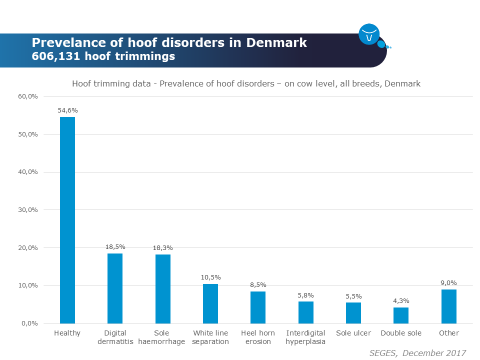
Compared to the UK, over 80% of the hoof diseases are on the back feet, 43% sole ulcer (incl. bruising), 30% infections such as digital dermatitis and 26% were classified as white line diseases. The data in Table 6 was obtained during routine hoof trimming visits for both lame and non-lame cows presented for trimming.
Table 6
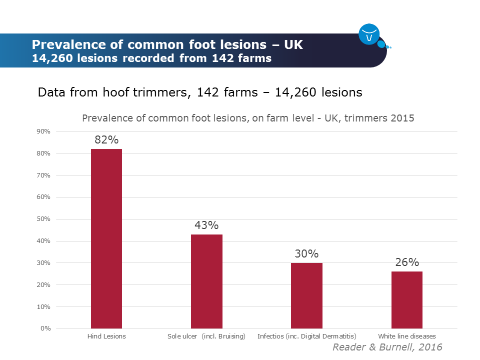
Management plays a crucial role in Scandinavian cattle breeding success. An increasing number of farmers in the Nordic countries genomically test all their heifers in the herd on the NTM scale to ensure they bred the best females for the next generation. The next step is to use that information to make their dairy business more efficient by using sexed semen on the top 30% of females and beef semen on the remaining 50–70%.
Summary
• Breeding is a crucial part of a successful dairy business.
• Strict veterinary rules in the Nordic countries with restricted use of antibiotics has forced the dairy industry to find other ways of keeping cows healthy.
• Good management and breeding for better health ensure profitability.
• The Nordic countries have both the lowest use of antibiotics in EU and the highest yield per cow.
• Nordic countries have been breeding for health traits for 40 years, and have a registration system with relevant data on approximately 900,000 cows.